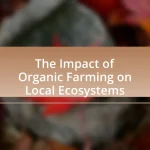Community Supported Agriculture (CSA) is a model that connects consumers directly with local farmers by allowing them to purchase shares of a farm’s harvest in advance. This system not only provides farmers with necessary upfront capital but also ensures consumers receive fresh, seasonal produce, thereby promoting local food systems and sustainability. The article explores the operational dynamics of CSAs, their environmental benefits, and their role in supporting local economies. It also addresses challenges faced by CSAs, strategies for enhancing their effectiveness, and ways individuals can engage with these initiatives to foster sustainable agricultural practices.

What is Community Supported Agriculture and its significance in sustainability?
Community Supported Agriculture (CSA) is a system where consumers purchase shares of a farm’s harvest in advance, providing farmers with upfront capital and consumers with fresh, seasonal produce. This model fosters a direct relationship between farmers and consumers, promoting local food systems and reducing the carbon footprint associated with transportation. CSAs contribute to sustainability by encouraging biodiversity through diverse crop production, supporting local economies, and minimizing food waste, as consumers receive a variety of produce that reflects the season’s yield. Studies indicate that CSAs can lead to a 25% reduction in greenhouse gas emissions compared to conventional food distribution methods, highlighting their role in sustainable agriculture practices.
How does Community Supported Agriculture operate?
Community Supported Agriculture (CSA) operates by creating a direct partnership between farmers and consumers, where consumers purchase shares of the farm’s harvest in advance. This model provides farmers with upfront capital to cover production costs and ensures consumers receive fresh, seasonal produce throughout the growing season. According to a study published in the Journal of Agriculture, Food Systems, and Community Development, CSAs can enhance local food systems by fostering community relationships and reducing the carbon footprint associated with food transportation.
What are the key components of Community Supported Agriculture?
The key components of Community Supported Agriculture (CSA) include a direct relationship between farmers and consumers, shared risks and benefits, and a subscription-based model for purchasing produce. In CSA, consumers buy shares of a farm’s harvest in advance, which provides farmers with upfront capital to grow crops while consumers receive fresh, seasonal produce throughout the growing season. This model fosters community engagement and supports local economies, as it encourages consumers to connect with their food sources and promotes sustainable agricultural practices. Studies show that CSAs can enhance food security and reduce the carbon footprint associated with food transportation, reinforcing their role in promoting sustainability.
How do these components contribute to sustainability?
Community Supported Agriculture (CSA) components contribute to sustainability by fostering local food systems, reducing carbon footprints, and promoting biodiversity. By connecting consumers directly with local farmers, CSAs minimize transportation emissions associated with food distribution, as food is sourced from nearby producers. This localized approach not only supports the local economy but also encourages the consumption of seasonal produce, which is often grown using sustainable practices. Furthermore, CSAs typically promote organic farming methods that enhance soil health and biodiversity, leading to more resilient ecosystems. Studies indicate that local food systems can reduce greenhouse gas emissions by up to 25% compared to conventional food supply chains, reinforcing the sustainability benefits of CSAs.
What are the environmental benefits of Community Supported Agriculture?
Community Supported Agriculture (CSA) offers significant environmental benefits, primarily through reduced carbon footprints and enhanced biodiversity. By connecting consumers directly with local farmers, CSAs minimize transportation emissions associated with food distribution, as food is often grown and consumed within the same region. Research indicates that local food systems can reduce greenhouse gas emissions by up to 50% compared to conventional food supply chains. Additionally, CSAs promote sustainable farming practices, such as crop rotation and organic farming, which improve soil health and increase biodiversity. Studies show that farms practicing these methods can support a wider variety of plant and animal species, contributing to healthier ecosystems.
How does Community Supported Agriculture reduce carbon footprints?
Community Supported Agriculture (CSA) reduces carbon footprints by minimizing transportation emissions associated with food distribution. In a CSA model, consumers purchase shares of produce directly from local farmers, which significantly shortens the supply chain. This local sourcing reduces the need for long-distance transportation, which is a major contributor to greenhouse gas emissions. According to a study published in the journal “Sustainability,” local food systems can reduce carbon emissions by up to 25% compared to conventional food systems that rely on extensive transportation networks. Additionally, CSAs often promote organic farming practices that enhance soil health and carbon sequestration, further contributing to lower overall carbon footprints.
What role does local food production play in sustainability?
Local food production plays a crucial role in sustainability by reducing transportation emissions and supporting local economies. By sourcing food from nearby farms, communities minimize the carbon footprint associated with long-distance food transport, which accounts for a significant portion of greenhouse gas emissions in the food supply chain. Additionally, local food production fosters economic resilience by keeping money within the community, as studies show that local food systems can generate up to three times more economic activity compared to conventional food systems. This dual impact of environmental and economic benefits underscores the importance of local food production in promoting sustainability.
How does Community Supported Agriculture support local economies?
Community Supported Agriculture (CSA) supports local economies by creating direct financial relationships between consumers and local farmers. This model allows farmers to receive upfront payments for their produce, which enhances their cash flow and reduces financial risk. According to a study by the USDA, CSAs can increase farm income by up to 50% compared to traditional sales methods. Additionally, CSAs encourage local spending, as consumers are more likely to purchase additional goods from local businesses, thereby stimulating the local economy. This direct connection fosters community engagement and strengthens local food systems, ultimately contributing to economic resilience.
What economic advantages does Community Supported Agriculture provide to farmers?
Community Supported Agriculture (CSA) provides farmers with economic advantages such as guaranteed income and reduced market risk. By selling shares of their harvest directly to consumers before the growing season, farmers secure upfront capital, which helps cover production costs. This model minimizes the uncertainty associated with traditional market sales, where prices can fluctuate. Additionally, CSAs often foster a loyal customer base, leading to consistent sales and reduced marketing expenses. Studies indicate that farmers involved in CSAs can achieve higher profit margins compared to conventional farming methods, as they eliminate intermediaries and retain a larger portion of the retail price.
How does Community Supported Agriculture foster community engagement?
Community Supported Agriculture (CSA) fosters community engagement by creating direct relationships between consumers and local farmers. This model encourages members to invest in local agriculture, which leads to increased participation in farm activities, such as planting and harvesting. Research indicates that CSAs enhance social networks and community ties, as members often share resources, recipes, and experiences, thereby strengthening community bonds. Additionally, a study published in the Journal of Agriculture, Food Systems, and Community Development found that CSAs contribute to local economies by keeping food dollars within the community, further promoting engagement and collaboration among residents.

What challenges does Community Supported Agriculture face in promoting sustainability?
Community Supported Agriculture (CSA) faces several challenges in promoting sustainability, primarily including economic viability, consumer engagement, and scalability. Economic viability is a significant hurdle, as many CSA farms struggle to cover operational costs while providing affordable produce to members. According to a study by the USDA, nearly 50% of small farms operate at a loss, which can hinder their ability to implement sustainable practices.
Consumer engagement presents another challenge; while CSAs rely on community support, fluctuating membership can lead to inconsistent revenue streams. Research indicates that maintaining a stable membership base is crucial for the sustainability of CSA programs. Additionally, scalability issues arise when attempting to expand CSA models to larger populations, as logistical complexities and resource limitations can impede growth.
These challenges collectively impact the effectiveness of CSAs in promoting sustainable agricultural practices, highlighting the need for innovative solutions and community support to overcome these barriers.
How do market dynamics affect Community Supported Agriculture?
Market dynamics significantly influence Community Supported Agriculture (CSA) by shaping consumer demand, pricing, and the availability of local produce. Changes in consumer preferences towards organic and locally sourced food can increase CSA membership, as seen in a 2020 study by the USDA, which reported a 20% rise in CSA participation during the pandemic due to heightened interest in food security and local sourcing. Additionally, fluctuations in market prices for conventional produce can affect the pricing strategies of CSAs, compelling them to adjust their subscription fees to remain competitive while ensuring sustainability. Thus, market dynamics directly impact the operational viability and growth potential of CSAs.
What are the common barriers to entry for new Community Supported Agriculture initiatives?
Common barriers to entry for new Community Supported Agriculture (CSA) initiatives include financial constraints, lack of access to land, and insufficient community awareness or interest. Financial constraints often arise from the initial costs of establishing a farm, purchasing seeds, and equipment, which can deter potential farmers. Additionally, many aspiring CSA operators struggle to find affordable land, particularly in urban areas where agricultural space is limited. Furthermore, a lack of community awareness about the benefits of CSAs can hinder participation, as potential members may not understand the value of supporting local agriculture or the subscription model. These barriers collectively impede the growth and sustainability of new CSA initiatives.
How can Community Supported Agriculture adapt to changing consumer preferences?
Community Supported Agriculture (CSA) can adapt to changing consumer preferences by diversifying its offerings and incorporating flexible subscription models. By providing a variety of products, such as organic vegetables, fruits, and value-added items like jams or pickles, CSAs can cater to different dietary needs and preferences. Additionally, implementing flexible subscription options allows consumers to choose delivery frequency and product selection, aligning with their individual lifestyles. Research indicates that 70% of consumers prefer personalized shopping experiences, highlighting the importance of adaptability in meeting consumer demands.
What strategies can enhance the effectiveness of Community Supported Agriculture?
Strategies that can enhance the effectiveness of Community Supported Agriculture (CSA) include fostering strong community relationships, diversifying crop offerings, and implementing educational programs. Strong community relationships encourage member engagement and commitment, which can be seen in CSAs that maintain regular communication and host community events, leading to increased member retention rates. Diversifying crop offerings not only meets varied consumer preferences but also mitigates risks associated with crop failure, as evidenced by studies showing that diversified farms are more resilient to market fluctuations. Educational programs, such as workshops on sustainable farming practices, empower members with knowledge and skills, thereby enhancing their connection to the CSA and promoting sustainable practices within the community.
How can technology improve Community Supported Agriculture operations?
Technology can improve Community Supported Agriculture (CSA) operations by enhancing communication, streamlining logistics, and optimizing resource management. Digital platforms facilitate direct communication between farmers and consumers, allowing for real-time updates on crop availability and farm activities, which increases transparency and consumer engagement. Additionally, software solutions can optimize delivery routes and schedules, reducing transportation costs and minimizing carbon footprints. Data analytics can also help farmers make informed decisions regarding crop selection and resource allocation, leading to increased efficiency and sustainability. For instance, a study by the USDA found that farms utilizing technology for data management reported a 20% increase in operational efficiency.
What role do educational programs play in promoting Community Supported Agriculture?
Educational programs play a crucial role in promoting Community Supported Agriculture (CSA) by increasing awareness and understanding of sustainable farming practices among consumers and farmers. These programs educate participants about the benefits of local food systems, the importance of supporting local farmers, and the environmental advantages of sustainable agriculture. For instance, research conducted by the USDA shows that educational initiatives can lead to a 30% increase in CSA membership when consumers are informed about the ecological and economic benefits of participating in such programs. By fostering a deeper connection between consumers and local agriculture, educational programs enhance community engagement and support for CSAs, ultimately contributing to the sustainability of local food systems.

How can individuals get involved with Community Supported Agriculture?
Individuals can get involved with Community Supported Agriculture (CSA) by subscribing to a local CSA program, which allows them to purchase a share of the farm’s harvest. This direct investment supports local farmers and provides consumers with fresh, seasonal produce. According to the USDA, CSAs have grown significantly, with thousands of programs operating across the United States, demonstrating their popularity and effectiveness in connecting communities with local agriculture. Additionally, individuals can participate in volunteer opportunities at farms, attend farm events, or engage in educational workshops to deepen their understanding of sustainable farming practices.
What are the different ways to participate in Community Supported Agriculture?
There are several ways to participate in Community Supported Agriculture (CSA), including subscribing to a CSA program, volunteering on a farm, and purchasing shares or memberships. Subscribing to a CSA program typically involves paying upfront for a share of the harvest, which provides consumers with regular deliveries of fresh produce. Volunteering on a farm allows individuals to contribute labor in exchange for produce or experience, fostering a direct connection with local agriculture. Purchasing shares or memberships can also include options for specific products, such as eggs or dairy, depending on the farm’s offerings. These methods not only support local farmers but also promote sustainable agricultural practices by encouraging community engagement and reducing food miles.
How can consumers find and support local Community Supported Agriculture programs?
Consumers can find and support local Community Supported Agriculture (CSA) programs by searching online directories, such as LocalHarvest.org, which lists CSA farms by location. Additionally, consumers can visit farmers’ markets, where many CSA programs promote their subscriptions, or connect with local agricultural organizations that often provide information about available CSAs in the area. Supporting these programs can involve purchasing a share of the harvest, which directly funds the farm and ensures consumers receive fresh, seasonal produce. According to a report by the USDA, CSAs contribute to local economies and promote sustainable farming practices, making them a beneficial choice for both consumers and the environment.
What are the benefits of joining a Community Supported Agriculture program for individuals?
Joining a Community Supported Agriculture (CSA) program offers individuals numerous benefits, including access to fresh, locally grown produce, which enhances dietary quality and supports local farmers. Participants in CSA programs typically receive a weekly share of seasonal fruits and vegetables, ensuring they consume a variety of nutritious foods. This direct relationship with local agriculture fosters a sense of community and connection to food sources, promoting sustainable practices. Additionally, studies show that CSA members often report higher satisfaction with their food choices and increased awareness of seasonal eating, which can lead to more environmentally friendly consumption patterns.
What best practices should be followed for successful Community Supported Agriculture initiatives?
Successful Community Supported Agriculture (CSA) initiatives should prioritize strong community engagement, transparent communication, and sustainable farming practices. Engaging the community fosters a sense of ownership and commitment, which is essential for the longevity of the initiative. Transparent communication about farming practices, crop availability, and financial aspects builds trust between farmers and consumers. Implementing sustainable farming practices, such as organic farming and crop rotation, not only enhances environmental health but also attracts consumers who value sustainability. Research indicates that CSAs with active community involvement and clear communication have higher retention rates and customer satisfaction, reinforcing the importance of these best practices.
How can Community Supported Agriculture programs ensure sustainability in their practices?
Community Supported Agriculture (CSA) programs can ensure sustainability in their practices by fostering direct relationships between farmers and consumers, which encourages local food production and reduces transportation emissions. By engaging community members as shareholders, CSAs promote organic farming methods, biodiversity, and soil health, which are essential for long-term agricultural sustainability. Research indicates that CSAs often utilize crop rotation and cover cropping, practices that enhance soil fertility and reduce reliance on chemical fertilizers. Additionally, CSAs typically prioritize seasonal produce, which aligns with sustainable farming practices and minimizes environmental impact.
What tips can help new Community Supported Agriculture initiatives thrive?
New Community Supported Agriculture initiatives can thrive by building strong relationships with their members. Engaging with the community through regular communication, such as newsletters and farm events, fosters trust and loyalty. Additionally, offering diverse and seasonal produce can attract a wider customer base, as studies show that consumers prefer fresh, local options. Implementing transparent pricing and clear membership benefits enhances member satisfaction and retention. Furthermore, collaborating with local businesses and organizations can expand outreach and support, as evidenced by successful initiatives that have increased membership through community partnerships.










